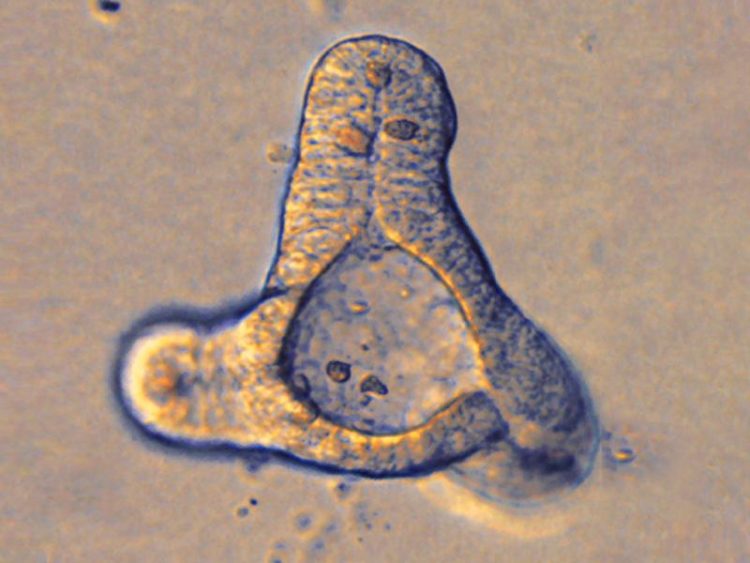Mini-intestine grown in a test tube

Organoids just a quarter of a millimeter across exhibit functions of the human intestine. (Photo: TUM/ Zietek)
Research efforts on the intestine have increased in recent years. Owing to its enormous surface area – comparable to that of a one-bedroom apartment – and the huge number of neurons it contains – comparable to that in the brain – the intestine is sometimes referred to as the abdominal brain.
In addition to absorbing nutrients from the foods we eat, it influences our immune status and metabolism. With the help of sensors, specialized cells in the intestinal wall determine which hormones, if any, should be released into the bloodstream. Overall, it acts as a highly sophisticated control center.
How an organoid grows from cells
Among their many functions, intestinal hormones, known as incretins, control blood glucose levels, appetite and fat metabolism. Diabetics and obese individuals have already been successfully treated with drugs based on the mechanisms of action of these hormones. However, still too little is known about the precise mechanism behind incretin release.
Applying a new method that is used mainly in stem-cell research and regenerative medicine, researchers from the Technical University of Munich have now devised a robust intestinal model for molecular research into incretin release in a test tube (in vitro).
To do so, they first isolate small pieces of intestine containing stem cells – in this case from mice. In the next step, a nutrient solution in a test tube stimulates the stem cells to develop into an organ-like structure. In just a few days, a spherical organoid forms that measures just a quarter of a millimeter across and is suitable for use in research.
Mini-intestine functions like normal intestinal tissue
“The special thing about our scientific work on the intestinal organoid is that we can observe its inner workings,” explains Dr. Tamara Zietek of the Department of Nutrition Physiology. “The mini-intestines exhibit all the essential functions of a real intestine,” the TUM scientist adds.
The intestinal organoid can:
actively absorb nutrients and drugs
release hormones after activation by nutrients
transmit signals within the intestinal cells to control these processes.
“Until now, it was not possible to investigate these processes in a single model, because conventional models are unsuitable for all these measurements,” says Zietek, the corresponding author of the article that appeared in Scientific Reports of the Nature Publishing Group. In addition, once mini-intestines have been grown, researchers can work with them for months, because they can be replicated in the laboratory.
“This drastically reduces the number of experimental animals needed,” says the scientist. Interdisciplinary collaboration Zietek developed the method in collaboration with Dr. Eva Rath of the Department of Nutrition and Immunology. Working on an interdisciplinary basis, the two scientists have combined organoid cultivation with molecular nutritional research. They are now demonstrating that the mini-intestine is an ideal model for investigating hormone release and transport mechanisms in the digestive tract.
“This is a huge advance for gastroenterological basic research as well as biomedical sciences and pharmacology,” Zietek believes. The next step will be to work with mini-intestines grown from human intestinal biopsy material. “We’re already in contact with a hospital that can provide the required research material.”In view of the growing number of diabetics and obese individuals, this method can help nutritional researchers develop new forms of treatment.
Publication:
Tamara Zietek, Eva Rath, Dirk Haller und Hannelore Daniel: Intestinal organoids for assessing nutrient transport, sensing and incretin secretion, Nature Scientific Reports 19.11.2015.
DOI: 10.1038/srep16831
Contact:
Dr. Tamara Zietek
Technical University of Munich
Department of Nutrition and Immunology
Phone: +49 (0)8161/71 3553
Mail: zietek@tum.de
http://www.tum.de/en/about-tum/news/press-releases/short/article/32752/
Media Contact
All latest news from the category: Life Sciences and Chemistry
Articles and reports from the Life Sciences and chemistry area deal with applied and basic research into modern biology, chemistry and human medicine.
Valuable information can be found on a range of life sciences fields including bacteriology, biochemistry, bionics, bioinformatics, biophysics, biotechnology, genetics, geobotany, human biology, marine biology, microbiology, molecular biology, cellular biology, zoology, bioinorganic chemistry, microchemistry and environmental chemistry.
Newest articles

“Nanostitches” enable lighter and tougher composite materials
In research that may lead to next-generation airplanes and spacecraft, MIT engineers used carbon nanotubes to prevent cracking in multilayered composites. To save on fuel and reduce aircraft emissions, engineers…

Trash to treasure
Researchers turn metal waste into catalyst for hydrogen. Scientists have found a way to transform metal waste into a highly efficient catalyst to make hydrogen from water, a discovery that…

Real-time detection of infectious disease viruses
… by searching for molecular fingerprinting. A research team consisting of Professor Kyoung-Duck Park and Taeyoung Moon and Huitae Joo, PhD candidates, from the Department of Physics at Pohang University…





















